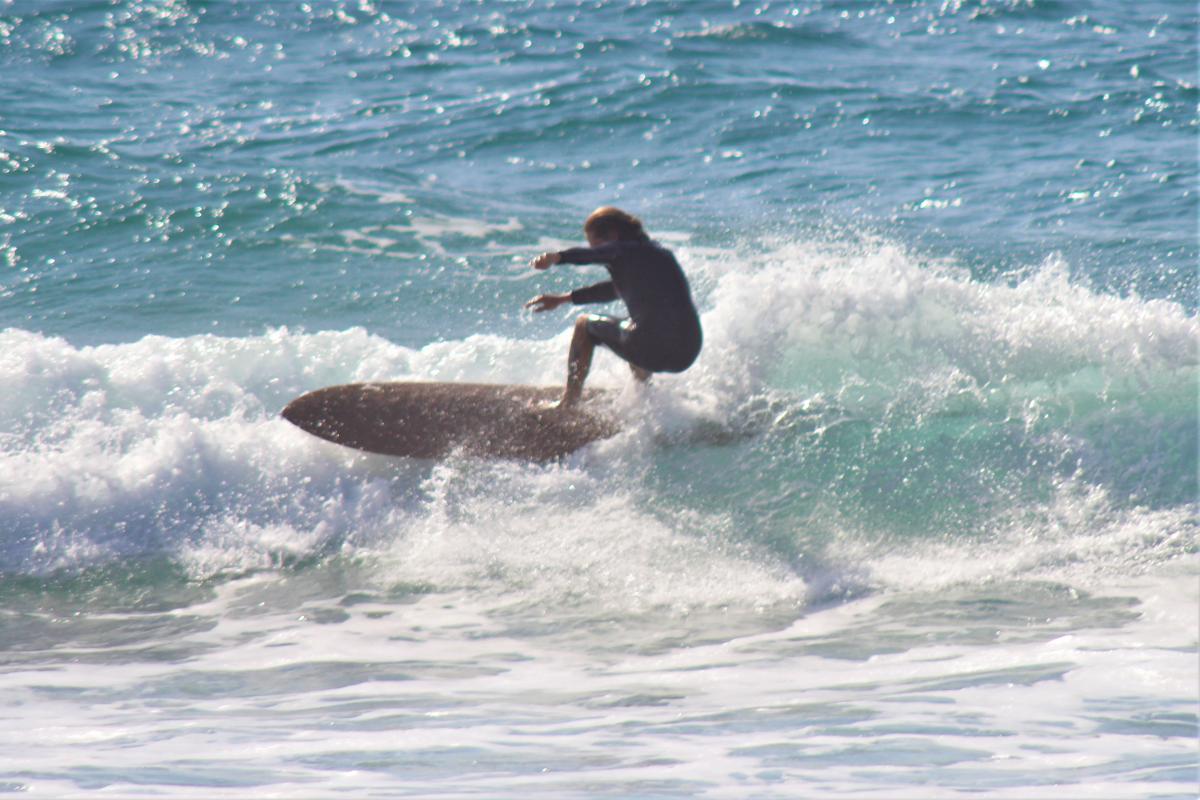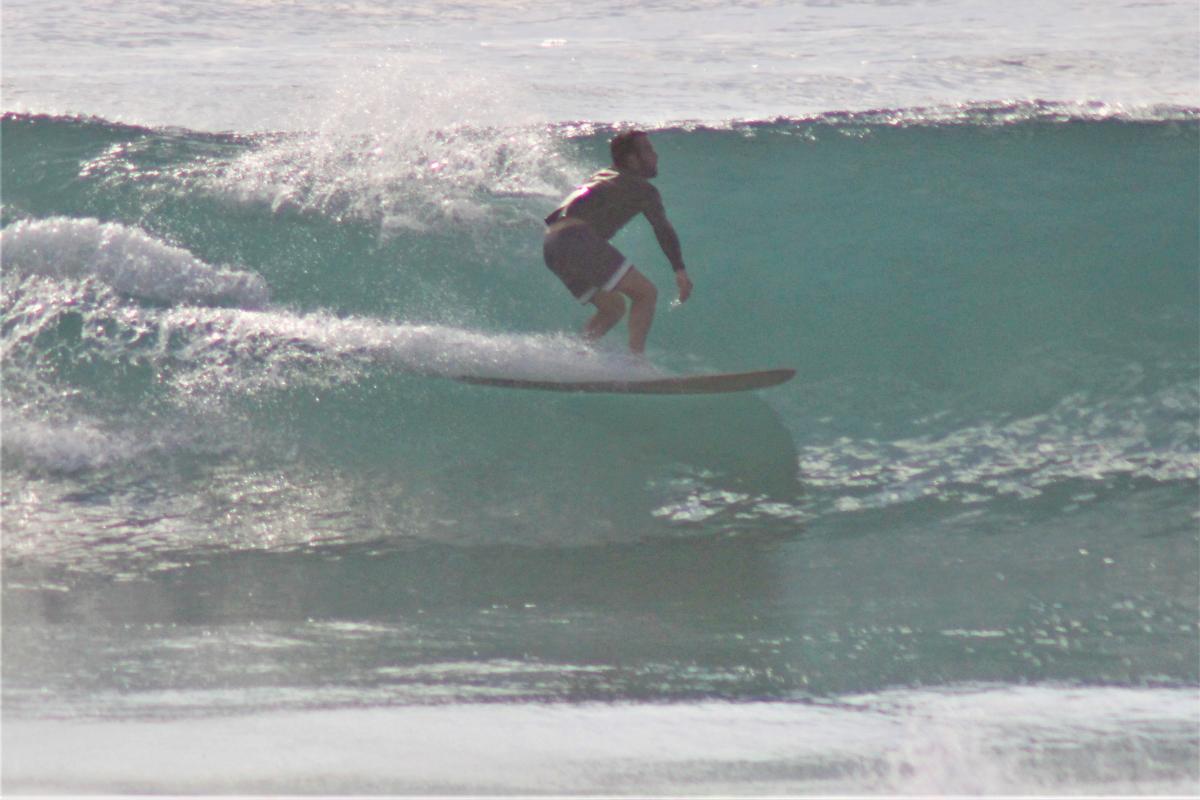
I use the analogy of driving a car to demonstrate the difference between finned and finless surfing. With a finned board all four wheels of the car are secure on the road when turning. With finless the four wheels are sliding as you drift around every corner and then accelerate out of the turn with a spring as the tires grab the road – or as the rails reengage with the wave.



Top: Harrison Biden skims across the lip on an albacore. Below Jacob Pedrana proves the albacore performs great in Bali. I desgined the Albacore in 2009 and now I am expanding on this design with the corky method.
The corky finless is the current phase in a long evolution in surfboard design
In 2005-6 Jacob Stuth and I found that flex and concave were the key ingredients to a good alaia. We wanted more flex but were limited by the properties wood. If we made a thin alaia and got the flex we wanted, the board soon cracked. I tried lots of ways to get floatation and flex and ended up working with Global Surf Industries in 2009 to create the Seaglass Project and the albacore. The albacore is a great board, but after 8 years, I wanted to be able to progress this design. Again, I faced the old problems of flexible boards cracking and buckling. I tried many methods and finally found I could use extra dense EPS and XPS foams along with cork and veneers of paulownia to make the boards I had dreamed. In 2017-2018 invented the corky method.


Jahmin Lerum on his "pop and spin" Corky
The spring and flex in the tail gives a quick response to turning and a tight radius. This board is stiff through the middle for a fast skimming surface area.
Two designs of finless corkys
My finless boards have evolved into two different designs. Some people like the “Pop and Spin” style which is to drive off a bottom turn and then release from the surface of the water and drift or spin across the shoulder. There is a real buzz from flying across a wave with minimal control. The boards actually accelerate as they release from the water and skim like an air hockey puck across the wave.




Gus O'Mally demonstrates the "pop and spin" approach.
The second design is about maintaining control on steep faces and carving rail turns. This is my favourite aspect of finless riding. I love fading left and then doing a carving bottom turn where my board flexes into a quarter circle and then flings me up the face of the wave where I have control in choosing my line.


Above Harrison Biden using the rail and flex to carve turns on the longer, 6'6 corky. The board in the bottom shot is just XPS foam on the deck.

Jacob Pedrana using all edge to shoot towards the lip.
By working with flex patterns and templates I can adjust how the board will move through and on top of the water.
I have worked with many other boards to really understand the dynamics of finless shapes. I am always open to trying something new!

Gus O'Mally on a corking testing day in Noosa. He could not pick a favourite of these three boards.
Please click here. I have written in a much more detailed evolution of my journey from alaias to foam finless boards (Hyperlink)
(Tom, put in Seaglass part from website and maybe add Albacore video at end. Also, add more tuna videos)
Latest Evolution
Working with a great team of finless riders; Gus O'Mally, Simon Pettiford and Joe Harding, we took the finlss boards to a new place. The holy grail for finless surfing is the carving cutback. It is the ultimate in transitioning from sliding on top of the water like a hockey puck on ice, to cutting into the wave face and pushing against the wave with all your weight to change direction. Over the Christmas holidays of 2018 to 2019 the team and I set to making a board that will pull the roundhouse cutback. Here is our story.
Prices:
Corky
5-6’ $800
6-7’ $900
7’ and up price on application
Solid Wood Alaias
Tom Wegener Alaias
I spent four years, 2005 to 2009, focussing on alaia shapes and the ancient Hawaiian culture which developed them. I made many hundreds alaias and have studied their ancestors in the annex of the Bishop Museum in Hawaii on two occasions. I still make these boards, but mostly, this design has been absorbed into my corky finless category. To see my alaia history please click here..
I can still make my original style alaias from solid pieces of paulownia. Some people relish the difficulty of surfing the real thing – an alaia from ancient Hawaii.
Further information on alaias, please click here (link to current alaia story page)
Solid wood alaia prices:
4’ original surfie style $500
5-6 Alaia (Finley, Stuth or Peanut style) $900
7’ and up, price upon application.ss surfing and the Alaias
Below is a video I made in 2011 about how to judge finless surfing. I made it for the f Noosa Festival of Surfing Pro Finless Division. The cutback Gus and I are talking about in the video above is two minutes into this video. When I saw Rasta perform this cutback, I saw what is possible and what the ancient Hawaiian were probably doing. I could not get this image out of my head and have been pursuing a board which will to this. Yes, an alaia can do it, but almost nobody can surf an alaia copy Rasta's cutback. My goal has been to bring this manuever to user friendly finless surfboards.


